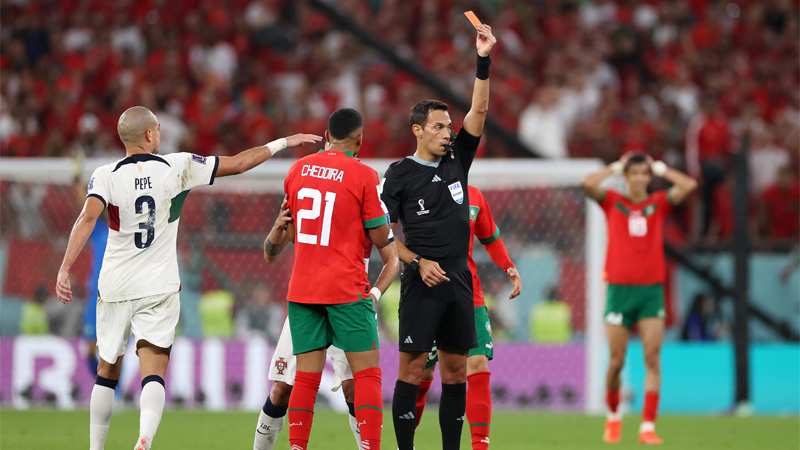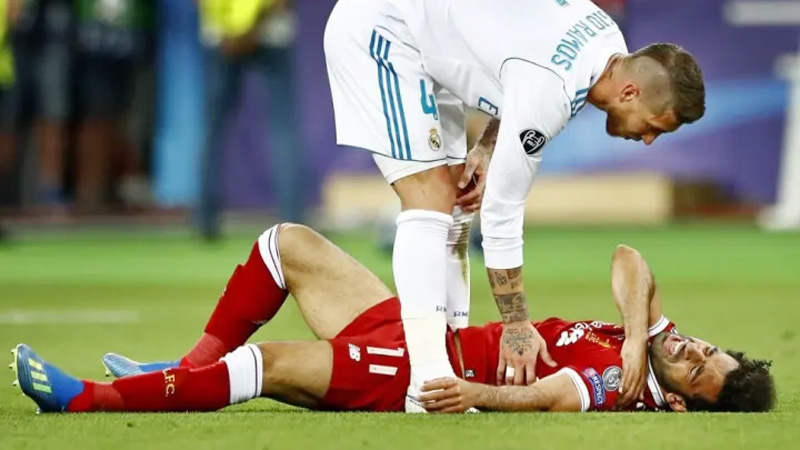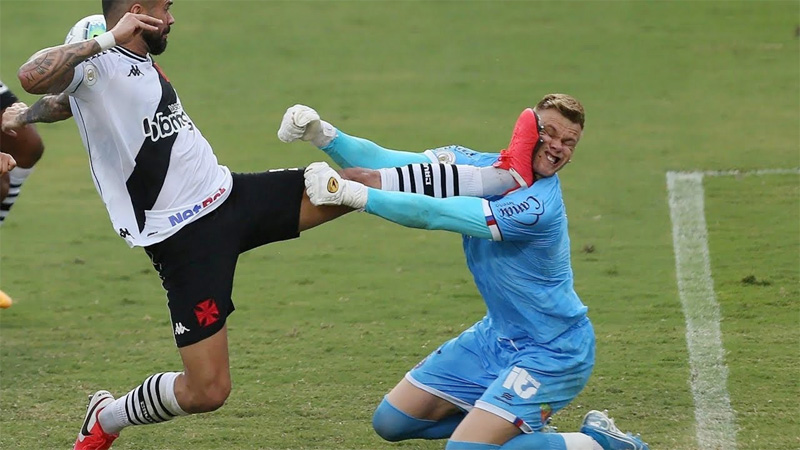Dangerous play in soccer refers to actions or behaviors on the field that pose a risk of injury to players involved in the game. It encompasses a range of situations, from high kicks and cleats-up challenges to reckless tackles and the use of elbows during challenges.
The concept of what is dangerous to play in soccer aims to prevent serious injuries and promote a positive sporting environment.
Soccer’s governing bodies, along with match officials, enforce rules against dangerous play to ensure that players adhere to a code of conduct that prioritizes the well-being of all participants on the pitch.
What Is Dangerous Play In Soccer?
Dangerous play in soccer, also known as a high kick or a dangerous high kick, refers to a situation where a player’s actions on the field can pose a risk of injury to themselves or other players.
The concept of dangerous play is designed to promote safety and fair play in the game.
Here are some instances that can be considered as dangerous play:
High Kicks
When a player lifts their leg to an excessive height near an opponent’s head, it can be deemed dangerous play.
High kicks, especially with studs exposed, can lead to serious head injuries or facial cuts if contact is made with an opposing player’s head or face.
Cleats-Up Challenges
Players must exercise caution when challenging for the ball, especially with their cleats raised. A player who raises their studs into the air during a tackle can endanger the safety of an opponent by potentially causing cuts or severe injuries.
Playing While Injured
If a player continues to play despite being injured and unable to move safely on the field, it can be considered dangerous play.
A player who is hurt may put themselves at risk of exacerbating the injury or endangering other players by not being able to control their movements adequately.
Playing in a Reckless Manner
Actions such as intentionally fouling opponents or committing dangerous challenges with a lack of regard for the safety of others can also be classified as dangerous play.
Reckless challenges can lead to severe injuries and are generally frowned upon in the sport.
Obstructing Goalkeepers
Deliberately obstructing a goalkeeper during set pieces or preventing them from releasing the ball safely is also considered dangerous play.
It can lead to collisions and injuries for both the goalkeeper and the obstructing player.
Referees are responsible for identifying and penalizing dangerous play during a match.
Depending on the severity of the action, the referee may award a free-kick, caution the offending player with a yellow card, or even send them off with a red card, especially in cases of serious endangerment or recklessness.
By enforcing the rules against dangerous play, soccer aims to maintain a safe and enjoyable playing environment for all participants.
What Are The Consequences Of Dangerous Play In Soccer?

Source: TheAthleticFC
Here are some common consequences of dangerous play in soccer-
Free Kick or Indirect Free Kick
When a player is deemed to have committed a less severe case of dangerous play, the opposing team is awarded a free kick or an indirect free kick, depending on the specific situation and the laws of the game.
The free kick allows the opposing team to gain an advantage by restarting play from the location of the foul, enabling them to build an attacking move or create goal-scoring opportunities.
Yellow Card
In more serious instances of dangerous play, the offending player may receive a yellow card, also known as a caution.
The yellow card serves as a formal warning from the referee, and it is displayed for reckless or excessive fouls, including those involving dangerous play.
Accumulating multiple yellow cards throughout a match or tournament can result in a player being sent off with a red card.
Red Card and Sending Off
In severe cases of dangerous play that pose a significant risk of injury or show a lack of regard for the safety of others, the offending player may be shown a red card by the referee.
A red card results in the player’s immediate expulsion from the match, leaving their team with ten players for the remainder of the game. Additionally, players who receive a red card may face suspensions, depending on the competition’s regulations.
Suspension and Fines
In some cases, particularly in professional leagues or high-level competitions, players who are guilty of dangerous play may face further consequences, such as additional suspensions or fines imposed by the league or governing body.
These penalties aim to deter players from engaging in dangerous play and uphold the integrity of the sport.
Retrospective Punishment
In certain leagues or competitions with video review systems, instances of dangerous play that were missed by the match officials during the game can be subject to retrospective punishment.
The league or governing body may review the video footage and impose sanctions on the player involved, even after the match has concluded.
The consequences of dangerous play are designed to enforce player safety and maintain the spirit of fair play in soccer.
By penalizing such actions, the sport aims to create a safe and enjoyable environment for players, promoting respect and sportsmanship on and off the field.
What Are Some Examples Of Dangerous Plays In Soccer?

Source: 90min
Here are some popular examples of dangerous plays in soccer-
High Kicks
An example of dangerous play in soccer is when a player attempts a high kick in close proximity to an opponent’s head.
If a player raises their leg too high during a challenge or attempts to control the ball, it can lead to a dangerous situation where their foot comes dangerously close to an opponent’s face.
High kicks can cause serious head injuries, facial cuts, or even concussions if contact is made with the opposing player’s head.
Two-Footed Tackle
A two-footed tackle is another example of dangerous play. When a player lunges into a tackle with both feet off the ground, it can lead to a high-risk situation where they may mistime the challenge, endangering the safety of the opponent.
Two-footed tackles can result in serious injuries, including broken bones or ligament damage, and are generally considered reckless and dangerous.
Cleats-Up Challenges
Players must be cautious when challenging for the ball with their cleats raised. A cleats-up challenge occurs when a player raises their foot excessively high, potentially leading to studs making contact with an opponent’s leg.
Such challenges can cause severe injuries, including deep cuts or bruising, making them a dangerous aspect of play.
Elbowing or Leading with Arm
Elbowing or leading with the arm in challenges is another example of dangerous play. When a player uses their elbow to impede an opponent or make contact with an opponent’s head, it can cause serious injuries, such as cuts, bruises, or concussions.
Intentional or reckless use of the arm in this manner can lead to penalties or disciplinary actions.
Playing with High Boots
Wearing boots with studs that are too long or sharp can also contribute to dangerous play.
Long studs can increase the risk of slipping and causing collisions or accidents during challenges, especially on wet or uneven surfaces.
Players should ensure that their boots are appropriate and comply with safety regulations to reduce the risk of causing harm to themselves or others.
These examples illustrate various dangerous plays in soccer that pose risks of injury to players.
Soccer authorities and match officials are responsible for identifying and penalizing dangerous play during games to promote safety and fair play in the sport.
Players, coaches, and officials alike should prioritize player safety and encourage responsible play on the field.
FAQ
What is considered dangerous play in soccer?
Dangerous play in soccer refers to actions or behaviors on the field that pose a risk of injury to players involved in the game. It includes high kicks near opponents’ heads, two-footed tackles, cleats-up challenges, elbowing or leading with the arm in challenges, and playing with high boots that have long or sharp studs.
How do referees identify dangerous play during a match?
Referees are trained to closely monitor player actions and assess whether they pose a risk of injury to themselves or others. They look for high kicks, reckless tackles, and any challenge that involves studs being raised or excessive force used against an opponent.
What are the consequences of dangerous play in soccer?
The consequences of dangerous play in soccer can vary depending on the severity of the action and the discretion of the match officials.
Common consequences include awarding a free kick or an indirect free kick to the opposing team, issuing a yellow card as a formal warning to the offending player, and in severe cases, giving a red card resulting in the player’s immediate expulsion from the match.
How does soccer prioritize player safety regarding dangerous play?
Player safety is a top priority in soccer, and the rules against dangerous play are in place to protect the well-being of all participants. By penalizing dangerous actions, soccer’s governing bodies aim to deter players from engaging in reckless behaviors and promote responsible play on the field.
How can players avoid dangerous play on the field?
Players can avoid dangerous play by prioritizing safety and adhering to the laws of the game. They should focus on proper tackling techniques, keeping both feet on the ground during challenges, and using their arms responsibly.
Conclusion
Dangerous play in soccer is a critical aspect of the sport that demands careful consideration and enforcement to safeguard player safety and promote fair competition.
Players, coaches, and officials must be vigilant in identifying and penalizing instances of dangerous play to mitigate the risk of injuries and maintain the integrity of the game.
By emphasizing responsible and respectful play, soccer can continue to be a sport that captivates audiences worldwide while upholding the principles of fair play and sportsmanship.
A collective commitment to minimizing dangerous play will contribute to creating a safer and more enjoyable experience for everyone involved in the beautiful game of soccer.







